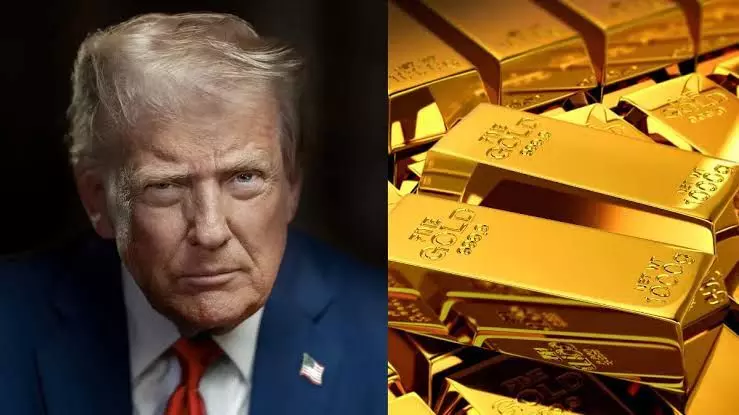How Trump’s tariffs can impact gold prices
A tariff-induced slowdown in trade and investment could also weaken the US dollar
By Anoushka Caroline Williams
How Trump’s tariffs can impact gold prices
Hyderabad: The recent announcement of high tariffs, particularly a 50 per cent tariff on India, by US President Donald Trump has injected fresh uncertainty into global markets.
While the exact details and timelines are unclear, analysts are already assessing the potential implications for gold, a commodity that often reacts strongly to inflation, currency movements and geopolitical shifts.
Understanding tariffs and subsequent inflation
Tariffs act as a tax on imported goods, making them more expensive for domestic buyers. In most cases, businesses pass these increased costs on to consumers, leading to higher prices across the economy.
“High tariffs generally lead to inflation, and that cost is ultimately paid by the American consumer,” said Satish Agarwal, partner at Kundan Jewellers and Exporters and a gold market analyst speaking to NewsMeter.
“Whenever the prices of essential goods rise, gold prices tend to move upward as well.”
Why inflation pushes gold prices higher
Gold is often viewed as a hedge against inflation.
When the cost of goods and services rises, the purchasing power of paper currency falls. In such situations, investors turn to assets like gold, which historically retain value over time.
“Whenever prices of something are increased, gold will definitely go up,” explained Agarwal. “It’s seen as a store of value, and in uncertain economic conditions, demand for gold as a safe haven rises.”
The dollar connection
A tariff-induced slowdown in trade and investment could also weaken the US dollar. If foreign investors see fewer opportunities in the US due to trade barriers or reduced competitiveness, they may pull capital out of the country.
“If the dollar falls because of a lack of investments, again gold will go up,” Agarwal noted. “A weaker dollar makes gold cheaper for buyers in other currencies, increasing global demand.”
Geopolitical risks add to the mix
Tariffs are rarely imposed in isolation.
They often escalate trade tensions between countries and can lead to broader geopolitical disputes. In times of geopolitical stress, gold is a preferred asset for investors looking to safeguard wealth.
“It’s like a safe haven,” said Agarwal. “Whenever there is unpredictability, whether from wars, trade disputes, or currency risks, people invest in gold.”
What if tariffs achieve their goal?
Trump has indicated that higher tariffs are aimed at making imported goods more expensive while offering incentives for companies to manufacture in the United States.
“We think he’s making the imported goods more expensive and giving more incentives for the companies in America,” Agarwal said. “But just tariffs are not the issue, it’s also about the skill set of the workforce, supply chain readiness and other factors that determine if such a plan will work.”
If the strategy succeeds in boosting domestic production without stoking inflation, gold prices could stabilise or even decline. “If everything goes well, the prices may even come down,” Agarwal added. “But right now, we don’t know what his plan for the future is.”
Short-term vs long-term outlook
For now, the uncertainty surrounding the tariff announcement, combined with ongoing geopolitical tensions, points toward firm or rising gold prices.
“The prices are here to stay or they will increase,” Agarwal concluded. “Until we see clarity on trade policy and its economic impact, gold will remain a preferred investment.”